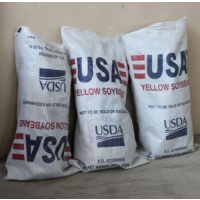U.S. Wasted $34 Million Pushing Soybeans on Afghanistan
 U.S. soybeans for Afghanistan (photo: SIGAR)
U.S. soybeans for Afghanistan (photo: SIGAR)
From military hardware to counternarcotics operations, the United States has invested billions of dollars in Afghanistan to rebuild, if not reshape, the war-torn country. Much of this investment has proved ineffective, and the failings of American policy now include a misguided effort involving soybeans.
Four years ago, the U.S. Department of Agriculture (USDA) decided it would be a good idea to spend $34 million on getting Afghan farmers to grow soybeans and for Afghan consumers to eat them.
The USDA struck out on both counts, according to a report (pdf) from the Office of the Special Inspector General for Afghanistan Reconstruction (SIGAR), a frequent critic of U.S. spending in the country, and the Center for Public Integrity.
For starters, American officials thought farmers in the nation’s northern reaches could successfully grow soybeans. This decision was made despite the findings of British researchers last decade that “soybeans were inappropriate for conditions and farming practices in northern Afghanistan, where the program was implemented,” SIGAR’s top official, John Sopko, wrote in a letter to Agriculture Secretary Tom Vilsack.
The U.S. also paid about $1.5 million to build a processing plant for soybeans. When the crops failed, the government paid to have 4,000 metric tons of soybeans flown in from the United States at a cost of about $2 million to keep the plant running.
Nor could American experts convince Afghans to incorporate soybeans into their diet. The Center for Public Integrity reported that this effort “has largely been a flop, marked by mismanagement, poor government oversight and financial waste.”
But even if the U.S. didn’t bungle its implementation of the soy-is-good-for-you strategy, the plan was likely to fail anyway, the center concluded, because of “a simple fact, which might have been foreseen but was evidently ignored: Afghans don’t like the taste of the soy processed foods.”
-Noel Brinkerhoff
To Learn More:
Afghans Don’t Like Soybeans, Despite a Big U.S. Push (by Alexander Cohen and James Arkin, Center for Public Integrity)
The U.S. Wasted $34 Million TryingTo Make Soybeans Happen In Afghanistan (by Hayes Brown, Think Progress)
Letter to Tom Vilsack (Special Inspector General for Afghanistan Reconstruction) (pdf)
More Than Three-Quarters of Soybeans, Corn and Cotton Grown in U.S. are Genetically Engineered (by Noel Brinkerhoff, AllGov)
- Top Stories
- Unusual News
- Where is the Money Going?
- Controversies
- U.S. and the World
- Appointments and Resignations
- Latest News
- Trump to Stop Deportations If…
- Trump Denounces World Series
- What If China Invaded the United States?
- Donald Trump Has a Mental Health Problem and It Has a Name
- Trump Goes on Renaming Frenzy






Comments